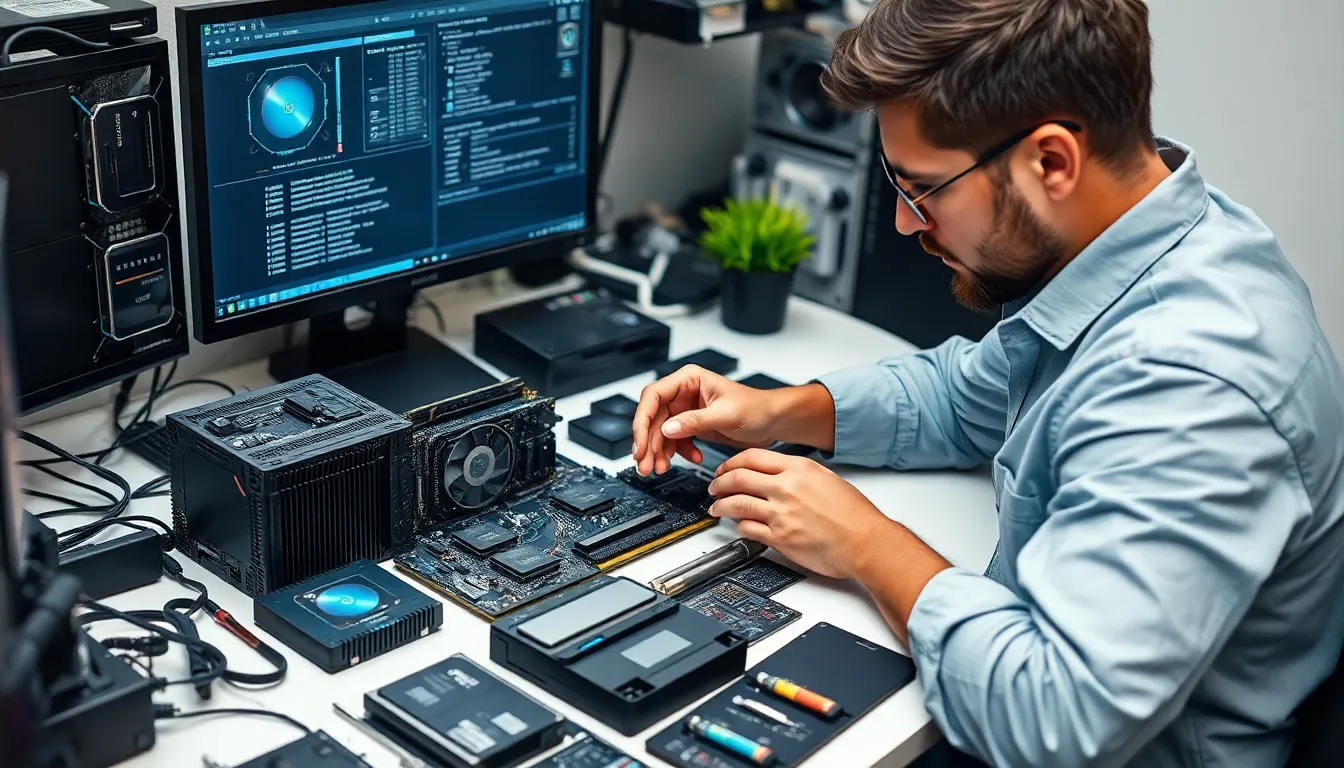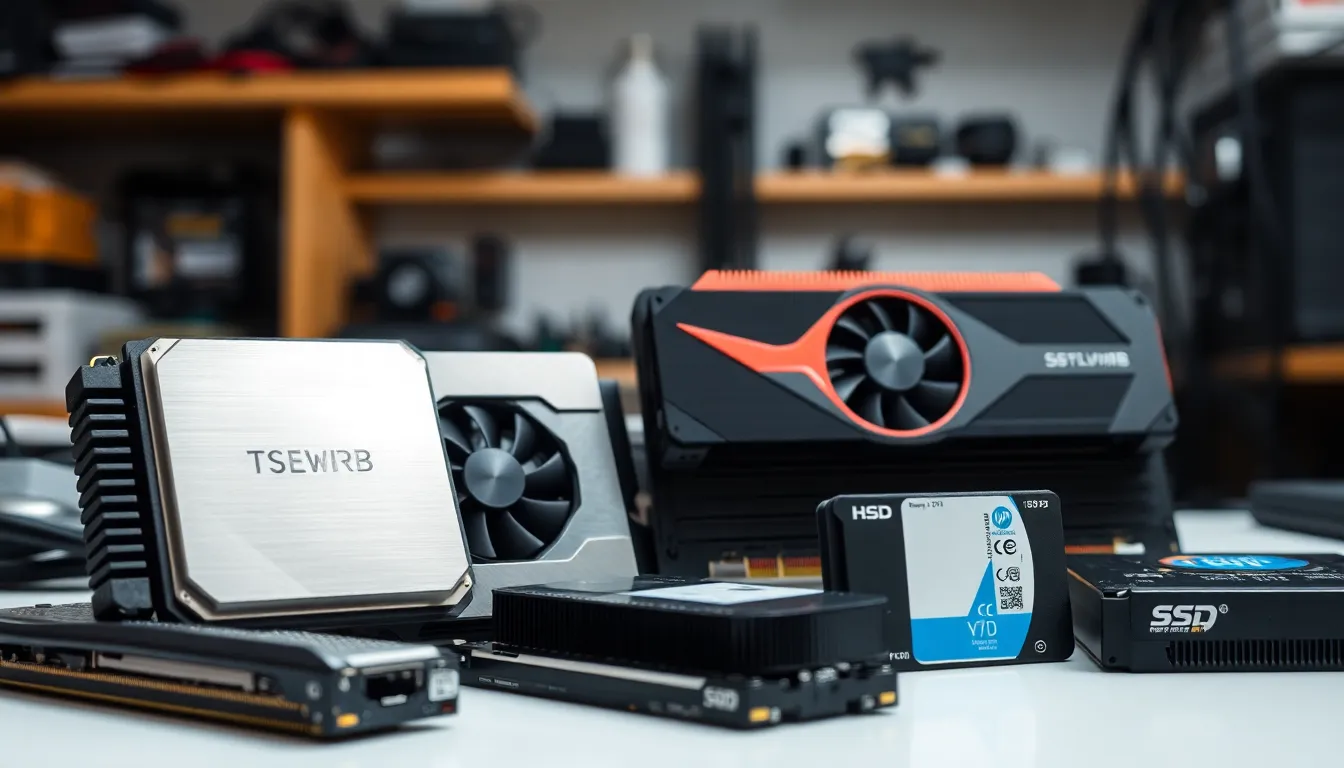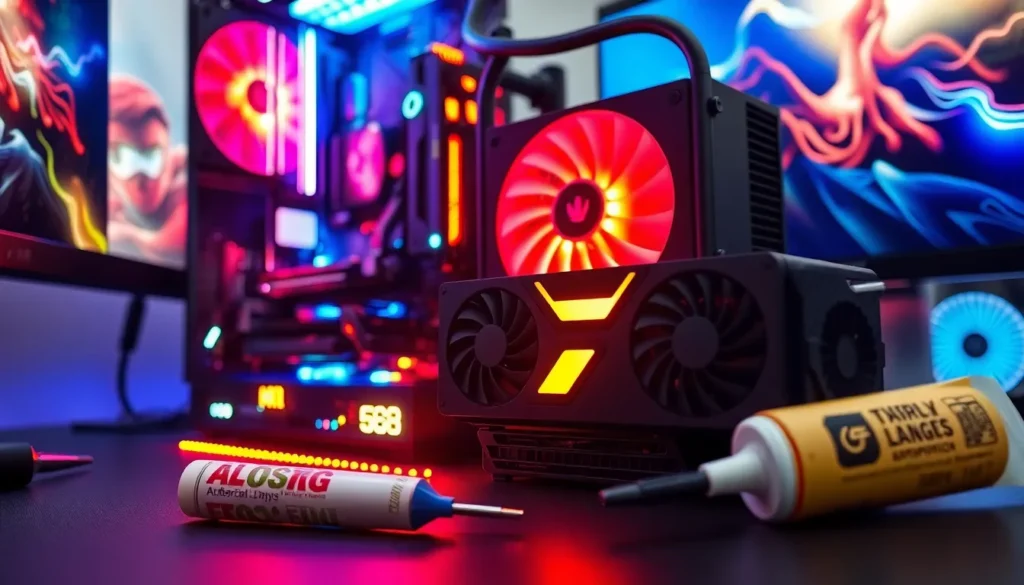Table of Contents
ToggleIn today’s digital age, understanding computer hardware is essential for anyone looking to navigate the tech landscape. From powerful processors to sleek graphics cards, the components that make up a computer play a crucial role in its performance and capabilities. With technology evolving at lightning speed, staying informed about the latest advancements can give users a significant edge.
Whether you’re a casual user, a gamer, or a tech enthusiast, knowing how hardware impacts your experience can lead to smarter purchasing decisions and optimized performance. This article dives into the fundamental aspects of computer hardware, helping readers grasp the critical components that power their devices and the innovations shaping the future of computing.
Overview of Computer Hardware
Computer hardware consists of the physical components that comprise a computer system. Each component plays a crucial role in the overall functionality and performance of the device. Understanding these components helps users make informed choices about upgrades or purchases.
Key Components of Computer Hardware
- Central Processing Unit (CPU)
The CPU serves as the brain of the computer. It processes instructions and performs calculations. Modern CPUs often feature multiple cores, enhancing multitasking capabilities.
- Random Access Memory (RAM)
RAM temporarily stores data that the CPU accesses for quick retrieval. More RAM allows for smoother operation of applications and better overall performance.
- Storage Drives
Storage drives retain data and applications for long-term use. Common types include Hard Disk Drives (HDDs) and Solid State Drives (SSDs). SSDs provide faster data access speeds compared to HDDs.
- Motherboard
The motherboard acts as the main circuit board, connecting all components, including the CPU, RAM, and storage drives. It facilitates communication between these parts to ensure proper functionality.
- Graphics Processing Unit (GPU)
The GPU specializes in rendering images and graphics. Gaming, video editing, and graphic design applications benefit significantly from dedicated GPUs, which enhance visual performance.
- Power Supply Unit (PSU)
The PSU converts electrical power from a wall outlet to the correct voltage for computer components. An efficient PSU ensures system stability and longevity.
- Cooling Systems
Cooling systems, such as fans and liquid cooling, prevent overheating during intensive tasks. Effective cooling is vital for maintaining hardware performance and longevity.
- Peripheral Devices
Peripheral devices expand the computer’s functionality. Examples include keyboards, mice, printers, and external storage devices. These components provide additional input and output capabilities.
Trends in Computer Hardware
- Performance Enhancements
Hardware continues to evolve, with new generations of CPUs and GPUs providing increased performance, power efficiency, and advanced features.
- Miniaturization
The trend towards smaller, more compact components has led to the development of more powerful laptops and mobile devices without sacrificing performance.
- Integration
Many modern devices combine hardware components into single chips. System-on-a-chip (SoC) designs enhance performance while reducing power consumption.
- Sustainability
Awareness of environmental impacts is prompting manufacturers to prioritize eco-friendly materials and energy-efficient designs, shifting the focus on sustainable hardware development.
Key Components of Computer Hardware


Understanding the key components of computer hardware is essential for comprehending overall system performance. The following sections provide details on the primary parts of a computer.
Central Processing Unit (CPU)
The Central Processing Unit (CPU) serves as the brain of the computer, executing instructions and processing data. Various architectures exist, including Intel and AMD, impacting performance and efficiency. Current generations of CPUs utilize multiple cores, allowing for improved multitasking and faster processing speeds. Faster clock speeds and cache sizes further enhance processing power, making the selection of a suitable CPU critical for any computing task.
Graphics Processing Unit (GPU)
The Graphics Processing Unit (GPU) is crucial for rendering images, videos, and animations. GPUs come in integrated and dedicated forms, with dedicated GPUs offering superior performance for gaming and graphic design applications. Modern GPUs support advanced rendering techniques such as ray tracing, improving visual fidelity in games and 3D applications. Their role in machine learning and artificial intelligence continues to grow, expanding their importance beyond traditional graphics tasks.
Memory (RAM)
Random Access Memory (RAM) enables smooth application operation by providing temporary storage for active processes. The capacity of RAM typically ranges from 8 GB to 64 GB for consumer systems, with higher capacities suitable for gaming and content creation. Faster RAM speeds, measured in MHz, contribute to improved system responsiveness. Dual-channel configurations enhance memory performance, allowing for more efficient data transfer.
Storage Devices
Storage devices retain data for long-term use, with Hard Disk Drives (HDDs) and Solid State Drives (SSDs) being the most common types. HDDs provide larger capacities at lower costs, but SSDs offer speed advantages, significantly reducing boot and load times. NVMe SSDs, utilizing PCIe interfaces, deliver even faster data transfer rates compared to traditional SATA SSDs. Hybrid solutions that combine both HDDs and SSDs provide a balance of cost, capacity, and performance for varied user needs.
Types of Computer Hardware
Computer hardware encompasses various categories that serve distinct functions, enabling effective operation in different environments. Key hardware types include desktops and laptops, servers, and peripheral devices.
Desktops and Laptops
Desktops and laptops are primary personal computing devices. Desktops, typically stationary, offer more upgrade options and processing power due to their larger space for components. They commonly house powerful CPUs, ample RAM, and significant storage capacity suited for demanding tasks. Laptops, portable yet powerful, use integrated components for space efficiency. They balance performance with battery life, making them ideal for mobile users. Notable brands include Dell, HP, and Apple, each offering unique features tailored to diverse user needs.
Servers
Servers function as centralized systems that manage resources and services for multiple users. They are optimized for reliability, with robust components to handle heavy workloads, such as high-performance CPUs, extensive RAM, and RAID storage configurations for redundancy. Servers can be physical or virtual, providing various services like file management, web hosting, and database systems. Common types include file servers, database servers, and application servers, each designed to execute specific tasks efficiently.
Peripheral Devices
Peripheral devices expand a computer’s capabilities and enhance user experience. These include input devices like keyboards and mice, output devices such as monitors and printers, and external storage like external hard drives. Each peripheral contributes to functionality; for example, high-resolution monitors improve visual work, while ergonomic keyboards boost productivity and comfort. Connectivity options like USB and Bluetooth facilitate seamless integration with main computing units, catering to diverse usage scenarios.
Emerging Trends in Computer Hardware
Innovations in computer hardware shape the future of technology. Key trends such as advancements in solid-state drives, cloud computing hardware, and quantum computing play significant roles in enhancing performance and efficiency.
Solid-State Drives (SSD)
Solid-state drives (SSDs) continue to dominate storage technology due to their speed and reliability. SSDs offer significantly faster read and write speeds compared to traditional hard disk drives (HDDs), reducing load times and improving overall system responsiveness. With advancements in NAND flash technology, SSDs can now achieve capacities of up to 8TB for consumer use, enabling large data storage without sacrificing performance. Furthermore, NVMe (Non-Volatile Memory Express) interfaces enhance transfer rates, making SSDs ideal for gaming, video editing, and data-intensive applications. The adoption of 3D NAND technology also contributes to cost-efficiency while increasing endurance and reliability, promoting broader usage among various user demographics.
Cloud Computing Hardware
Cloud computing hardware supports the infrastructure needed for extensive online services. Data centers, equipped with high-performance servers, utilize virtualization technologies to optimize resource usage, enabling multiple applications to run simultaneously on a single server. These systems often incorporate scalable storage solutions, allowing organizations to adjust capabilities based on demand seamlessly. Additionally, advancements in networking technologies, such as 5G, enhance connectivity, reducing latency and improving user experience. The trend toward edge computing, which involves processing data closer to the source, also emerges as vital in managing large data sets in real-time, facilitating faster analysis and improving application performance in industries like IoT and AI.
Quantum Computing
Quantum computing represents a dramatic shift in computational power, leveraging principles of quantum mechanics to perform calculations at unprecedented speeds. Unlike classical computers, quantum computers utilize qubits, capable of existing in multiple states simultaneously, allowing them to process vast amounts of data concurrently. This capability enhances problem-solving abilities in fields such as cryptography, complex modeling, and artificial intelligence. Companies like IBM and Google launch quantum processors that operate with increasing qubit counts, demonstrating the scalability of quantum technology. As advancements continue, quantum computing may redefine computational limits and unlock new possibilities across various sectors, including pharmaceuticals, finance, and material science.
Understanding computer hardware is vital for anyone looking to enhance their computing experience. As technology continues to evolve rapidly, staying informed about the latest advancements and trends is crucial. Knowledge of key components like CPUs, GPUs, and storage solutions empowers users to make better purchasing decisions tailored to their needs.
With innovations such as SSDs and cloud computing redefining the landscape, it’s clear that hardware plays a significant role in shaping the future of technology. By grasping these concepts, individuals can not only optimize their current systems but also prepare for the exciting developments on the horizon. Embracing this knowledge opens doors to improved performance and efficiency in an increasingly digital world.







